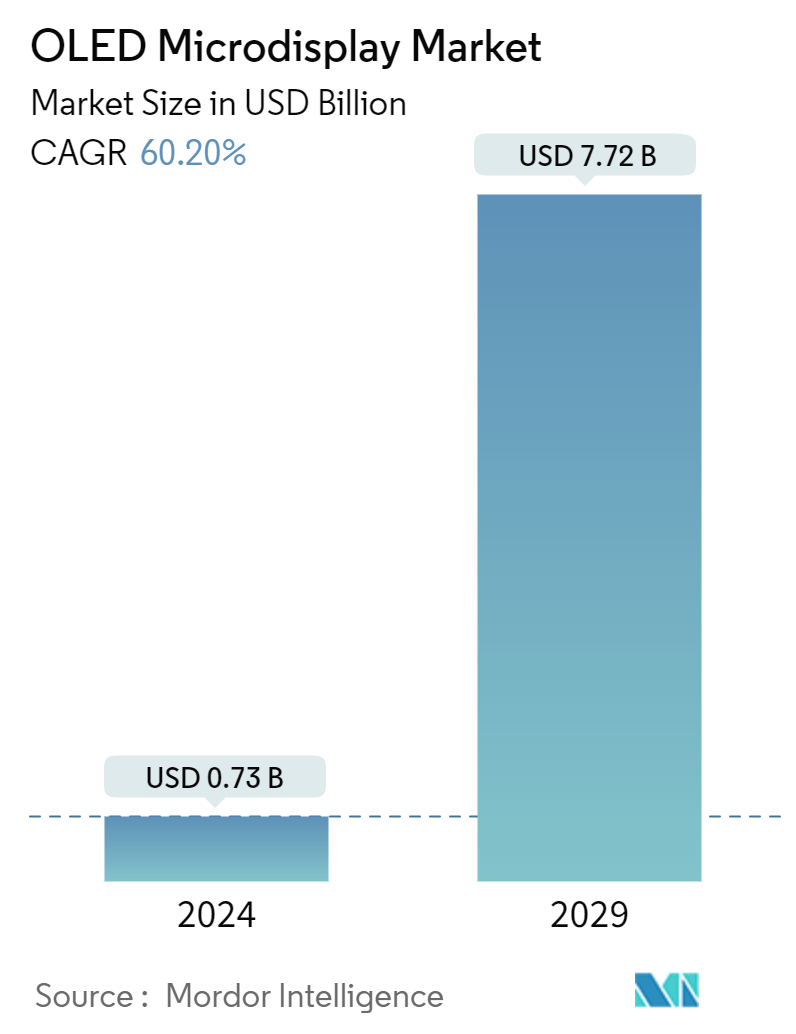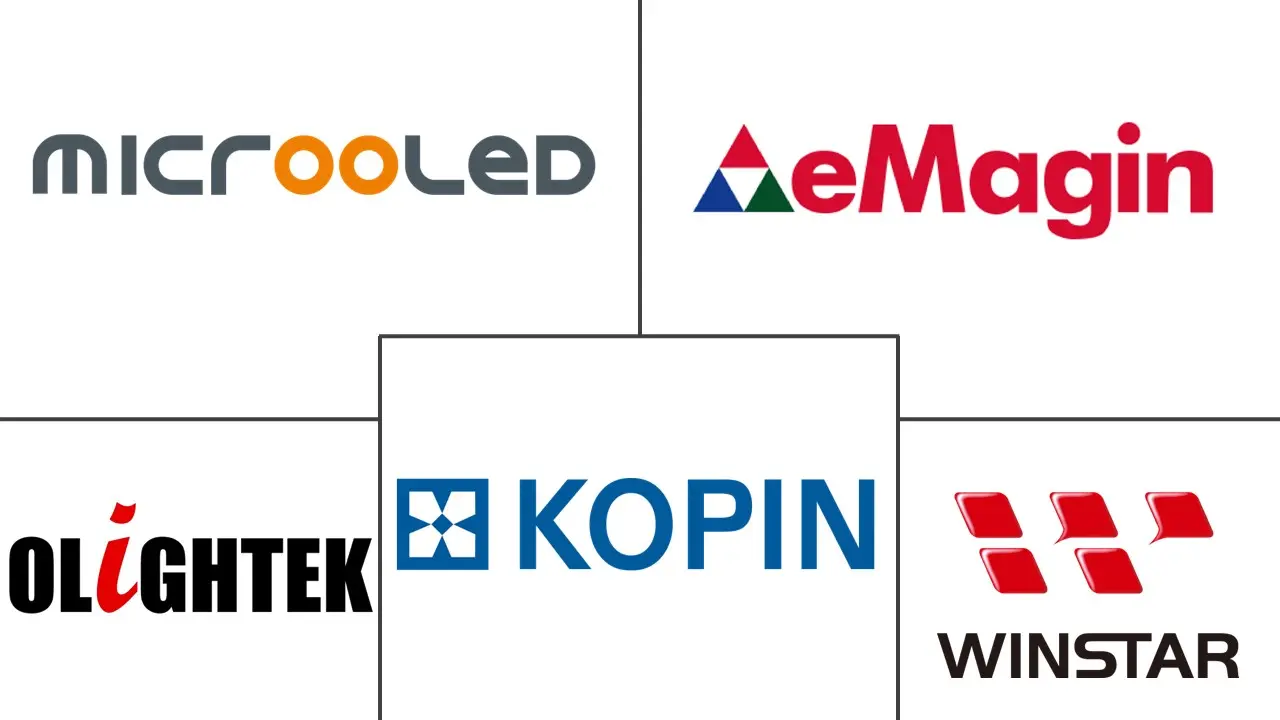Market Size of OLED Microdisplay Industry

| Study Period | 2019 - 2029 |
| Market Size (2024) | USD 0.73 Billion |
| Market Size (2029) | USD 7.72 Billion |
| CAGR (2024 - 2029) | 60.20 % |
| Fastest Growing Market | Asia Pacific |
| Largest Market | Asia Pacific |
Major Players
*Disclaimer: Major Players sorted in no particular order |
OLED Microdisplay Market Analysis
The OLED Microdisplay Market size is estimated at USD 0.73 billion in 2024, and is expected to reach USD 7.72 billion by 2029, growing at a CAGR of 60.20% during the forecast period (2024-2029).
- The OLED microdisplay market has been witnessing significant growth over the years. This is primarily due to the advancement of technologies such as AR/VR and the expansion of end-user industries across various regions. For instance, the transition toward 5G accelerates the demand for advanced near-to-eye devices. Further, TCL announced three of the latest AR/VR products at CES 2023. It includes products such as RayNeo X2, TCL NXTWEAR V, and TCL NXTWARE S.
- Due to contrast, power, size, and color-space advantages, NTE applications are anticipated to offer lucrative opportunities for OLED microdisplay. This relates to electronic viewfinders and personal viewers (PV). OLED microdisplay are finding widespread adoption in fields such as virtual reality (VR), augmented reality (AR), heads-up displays (HUDs), and wearable devices.
- One of the most striking features of OLED microdisplay is its high resolution. With a high pixel density, these displays offer a high level of detail, making them suitable for applications like VR headsets, augmented reality (AR) glasses, and head-mounted displays. The high resolution of OLED microdisplay ensures that users are presented with sharp, clear images, allowing for a truly immersive visual.
- The protection of OLED layers against water vapors and oxygen has been a significant challenge in developing OLED microdisplays, and it has played a role in restraining the market growth.
OLED Microdisplay Industry Segmentation
An OLED microdisplay is a small electronic visual display technology that produces bright and vibrant images with organic light-emitting diodes (OLEDs). It is often compact in size and is commonly used in electronic viewfinders for cameras, augmented reality (AR) devices, and other applications where a small, high-resolution display is required. The organic materials in OLEDs emit light when an electric current is applied, allowing individual pixels to emit light independently, resulting in high contrast ratios and efficient power consumption.
The OLED microdisplay market is segmented by type (near-to-eye and projections), end-user industry (automotive, healthcare, industrial, consumer electronics, aerospace and defense, law enforcement, and other end-user industries), and geography (North America, Europe, Asia-Pacific, and the Rest of the World). The report offers the market size in value terms in USD for all the abovementioned segments.
| By Type | |
| Near-to-eye | |
| Projections |
| By End-user Industry | |
| Automotive | |
| Healthcare | |
| Industrial | |
| Consumer Electronics | |
| Aerospace and Defense | |
| Law Enforcement | |
| Other End-user Industries |
| By Geography*** | |
| North America | |
| Europe | |
| Asia | |
| Australia and New Zealand | |
| Latin America | |
| Middle East and Africa |
OLED Microdisplay Market Size Summary
The OLED microdisplay market is experiencing robust growth, driven by advancements in technologies such as augmented reality (AR) and virtual reality (VR), and the expansion of end-user industries globally. The transition to 5G technology is further propelling the demand for advanced near-to-eye devices, with companies like TCL introducing new AR/VR products. OLED microdisplays are gaining traction in various applications, including VR headsets, AR glasses, and head-mounted displays, due to their high resolution and advantages in contrast, power, size, and color space. Despite challenges in protecting OLED layers from environmental factors, the market is buoyed by the increasing demand from the consumer electronics sector and rapid technological advancements, which compel original equipment manufacturers (OEMs) to innovate continuously.
The market's growth is also supported by the rising demand for smartphones and the increasing penetration of OLED folding mobile phones, as brands regularly launch new flagship devices with improved specifications. The Asia-Pacific region, particularly countries like South Korea, China, and Japan, is a significant hub for consumer electronics manufacturing and innovation, contributing to the market's expansion. The region's growing urbanization and disposable income among the middle class further create opportunities for OLED microdisplays. Major players in the market, such as Sony Semiconductor Solutions Corp. and BOE Technology Group, are investing in advanced technology and production facilities to meet the evolving consumer demands. The market remains fragmented, with key players adopting strategies like acquisitions and partnerships to enhance their offerings and maintain a competitive edge.
OLED Microdisplay Market Size - Table of Contents
-
1. MARKET DYNAMICS
-
1.1 Market Overview
-
1.2 Industry Value Chain Analysis
-
1.3 Industry Attractiveness - Porter's Five Forces Analysis
-
1.3.1 Bargaining Power of Suppliers
-
1.3.2 Bargaining Power of Buyers
-
1.3.3 Threat of New Entrants
-
1.3.4 Threat of Substitute Products
-
1.3.5 Degree of Competition
-
-
1.4 Impact of COVID-19 Aftereffects and Other Macroeconomic Factors on the Market
-
-
2. MARKET SEGMENTATION
-
2.1 By Type
-
2.1.1 Near-to-eye
-
2.1.2 Projections
-
-
2.2 By End-user Industry
-
2.2.1 Automotive
-
2.2.2 Healthcare
-
2.2.3 Industrial
-
2.2.4 Consumer Electronics
-
2.2.5 Aerospace and Defense
-
2.2.6 Law Enforcement
-
2.2.7 Other End-user Industries
-
-
2.3 By Geography***
-
2.3.1 North America
-
2.3.2 Europe
-
2.3.3 Asia
-
2.3.4 Australia and New Zealand
-
2.3.5 Latin America
-
2.3.6 Middle East and Africa
-
-
OLED Microdisplay Market Size FAQs
How big is the OLED Microdisplay Market?
The OLED Microdisplay Market size is expected to reach USD 0.73 billion in 2024 and grow at a CAGR of 60.20% to reach USD 7.72 billion by 2029.
What is the current OLED Microdisplay Market size?
In 2024, the OLED Microdisplay Market size is expected to reach USD 0.73 billion.

